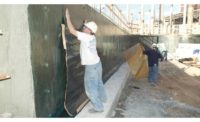Waterproofing: Cracking the Codes
Knowledge of Code Requirements Is Essential for Proper Waterproofing Design

Proper below-grade waterproofing design requires compliance with the International Code Council’s International Building Code (IBC). The code is very specific in regard to important waterproofing design elements. Sections of the code establish basic design criteria including where waterproofing is required, when waterproofing is required and how it is to be applied. Some of the key sections of the 2012 IBC that affect waterproofing design are highlighted in this article. Architectural Roofing & Waterproofing will explore this information in greater detail on Sept. 17 in an ARW University Webinar titled “Waterproofing Design by Code Requirements.”
Where Is Waterproofing Required?
1805.1 General. Walls or portions thereof that retain earth and enclose interior spaces and floors below grade shall be waterproofed and dampproofed in accordance with this section, with the exception of those spaces containing groups other than residential and institutional where such omission is not detrimental to the building or occupancy. Ventilation for crawl spaces shall comply with Section 1203.4.
Code Interpretation
This section implies that all occupied below-grade spaces require the application of a waterproofing or dampproofing material. The exception is to all unoccupied spaces. Once it has been determined that waterproofing or dampproofing is required, the next important decision is to determine where it is required. Typically, waterproofing or dampproofing should be applied over all below-grade concrete surfaces (walls and floors). There are several established building components that require waterproofing or dampproofing protection; they include:
- Underground structures
- Elevated structural slabs over underground spaces
- Structural slabs below grade
- Structural slabs above grade
- Foundations
- Lagging walls
- Plazas
- Terraces
- Promenades
- Planters
When Is Waterproofing Required?
1805.1.3 Ground-water control. Where the ground-water table is lowered and maintained at an elevation not less than 6 inches (152 mm) below the bottom of the lowest floor, the floor and walls shall be dampproofed in accordance with Section 1805.2. The design of the system to lower the ground-water table shall be based on accepted principles of engineering that shall consider, but not necessarily be limited to, permeability of the soil, rate at which water enters the drainage system, rated capacity of pumps, head against which pumps are to operate and the rated capacity of the disposal area of the system.
Code Interpretation
This section implies that dampproofing is required if the water table is maintained a minimum of six (6) inches below the bottom of the structure. If the water table is maintained within six (6) inches of the bottom of the structure or if hydrostatic pressure exists, then waterproofing is required.
It is the designer’s responsibility to review site-engineering analysis for water table conditions and soil analysis to determine if and what type of dampproofing or waterproofing is required.
The section also implies that the ground-water table must be lowered by implementing a drainage system that is designed to meet the following engineering principles:
- Permeability of the soil
- Rate at which water enters the drainage system
- Rated capacity of the pumps
- Head against which pumps are to operate
- Rate capacity of the designed area of the system
When Is Dampproofing Required?
1805.2 Dampproofing. Where hydrostatic pressure will not occur as determined by Section 1803.5.4, floors and walls for other than wood foundation systems shall be dampproofed in accordance with this section. Wood foundation systems shall be constructed in accordance with AF&PA PWF.
Code Interpretation
This section implies that dampproofing is required for all below-grade floors and walls where hydrostatic pressure will not occur. ASTM defines dampproofing as the treatment of a surface or structure to block the passage of water in the absence of hydrostatic pressure. Fundamentally, it only has the ability to resist vapor migration. If soil analysis concludes that there is no hydrostatic pressure or if the water table is more than six (6) inches below the lowest floor, then dampproofing may be considered.
Dampproofing is always applied at the exterior (wet) face of the wall. The most common dampproofing material for walls is a bituminous coating, either solvent-based (cutback asphalt) or emulsion, which is brushed, sprayed, roller-coated or troweled on the substrate. Dampproofing systems may also include membranes. The general difference between waterproofing systems and dampproofing systems is that dampproofing membranes maximize at 10-mil film thickness while waterproofing membranes exceed this thickness.
The section also implies that wood foundations shall be constructed in accordance with Permanent Wood Foundation Design Specification (ANSI/AF&PA PWF - 2007).
When Is Waterproofing Required?
1805.3 Waterproofing. Where the ground-water investigation required by Section 1803.5.4indicates that a hydrostatic pressure condition exists, and the design does not include a ground-water control system as described in Section 1805.1.3, walls and floors shall be waterproofed in accordance with this section.
Code Interpretation
This section implies that a waterproofing application is completed when the site ground-water table is maintained at an elevation of not less than six (6) inches below the bottom of the ground slab. The section states that waterproofing is required when hydrostatic pressure will occur.
It is the responsibility of the architect or designer to make certain that the waterproofing component is in compliance with the applicable Federal, State or Local codes. The primary distinction of the codes in regards to water table and hydrostatic pressure. A proper engineering study of the grounds is required to establish this criterion for the design phase.
Join Us for a Free Waterproofing Webinar
For more information on waterproofing and dampproofing, join us for the ARW University webinar titled “Waterproofing Design by Code Requirements.” The live event will air Sept. 17, and it will be available on demand after that date. For more information or to register, click here.
Looking for a reprint of this article?
From high-res PDFs to custom plaques, order your copy today!






